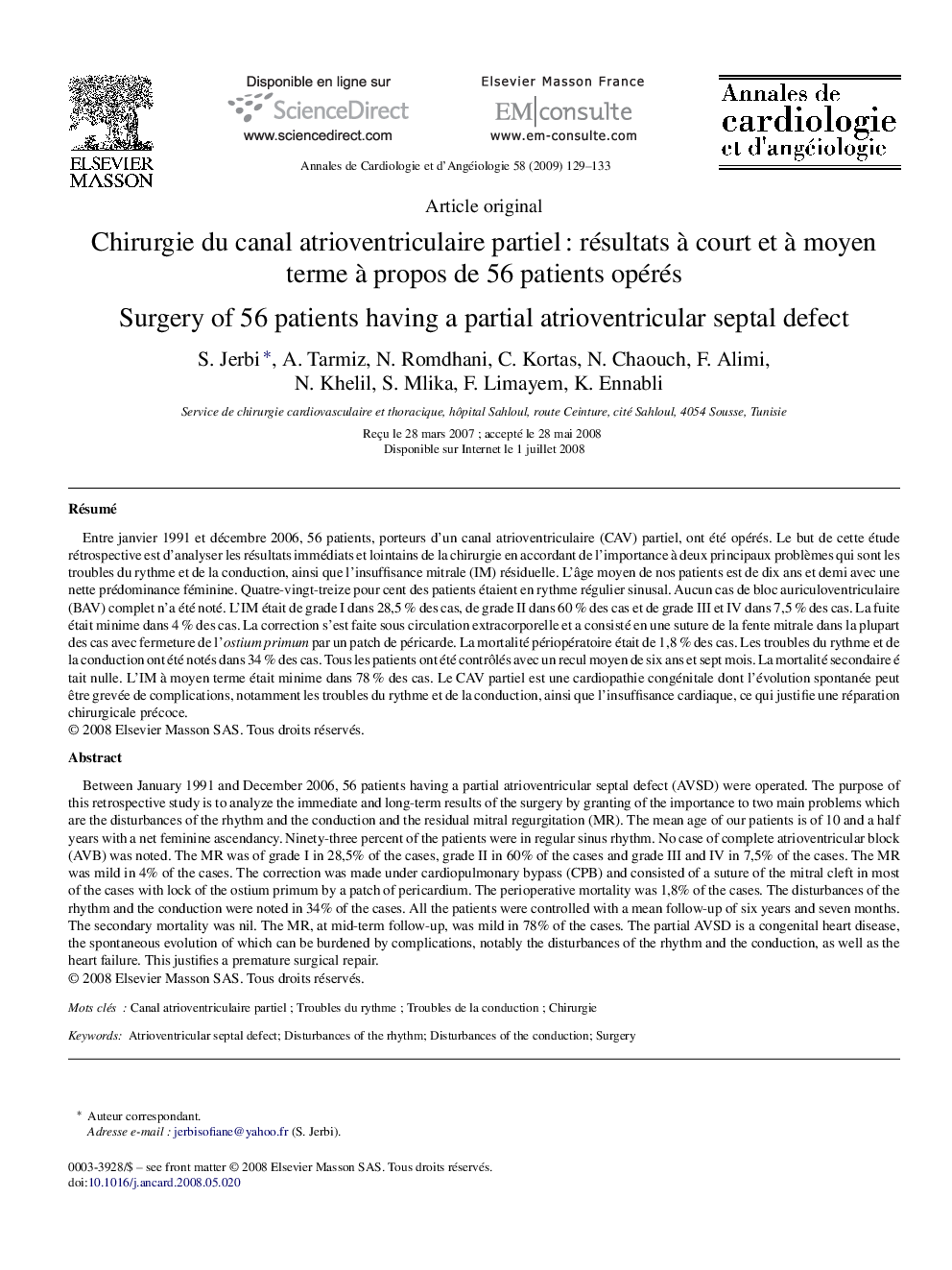| Article ID | Journal | Published Year | Pages | File Type |
|---|---|---|---|---|
| 2869358 | Annales de Cardiologie et d'Angéiologie | 2009 | 5 Pages |
RésuméEntre janvier 1991 et décembre 2006, 56 patients, porteurs d’un canal atrioventriculaire (CAV) partiel, ont été opérés. Le but de cette étude rétrospective est d’analyser les résultats immédiats et lointains de la chirurgie en accordant de l’importance à deux principaux problèmes qui sont les troubles du rythme et de la conduction, ainsi que l’insuffisance mitrale (IM) résiduelle. L’âge moyen de nos patients est de dix ans et demi avec une nette prédominance féminine. Quatre-vingt-treize pour cent des patients étaient en rythme régulier sinusal. Aucun cas de bloc auriculoventriculaire (BAV) complet n’a été noté. L’IM était de grade I dans 28,5 % des cas, de grade II dans 60 % des cas et de grade III et IV dans 7,5 % des cas. La fuite était minime dans 4 % des cas. La correction s’est faite sous circulation extracorporelle et a consisté en une suture de la fente mitrale dans la plupart des cas avec fermeture de l’ostium primum par un patch de péricarde. La mortalité périopératoire était de 1,8 % des cas. Les troubles du rythme et de la conduction ont été notés dans 34 % des cas. Tous les patients ont été contrôlés avec un recul moyen de six ans et sept mois. La mortalité secondaire était nulle. L’IM à moyen terme était minime dans 78 % des cas. Le CAV partiel est une cardiopathie congénitale dont l’évolution spontanée peut être grevée de complications, notamment les troubles du rythme et de la conduction, ainsi que l’insuffisance cardiaque, ce qui justifie une réparation chirurgicale précoce.
Between January 1991 and December 2006, 56 patients having a partial atrioventricular septal defect (AVSD) were operated. The purpose of this retrospective study is to analyze the immediate and long-term results of the surgery by granting of the importance to two main problems which are the disturbances of the rhythm and the conduction and the residual mitral regurgitation (MR). The mean age of our patients is of 10 and a half years with a net feminine ascendancy. Ninety-three percent of the patients were in regular sinus rhythm. No case of complete atrioventricular block (AVB) was noted. The MR was of grade I in 28,5% of the cases, grade II in 60% of the cases and grade III and IV in 7,5% of the cases. The MR was mild in 4% of the cases. The correction was made under cardiopulmonary bypass (CPB) and consisted of a suture of the mitral cleft in most of the cases with lock of the ostium primum by a patch of pericardium. The perioperative mortality was 1,8% of the cases. The disturbances of the rhythm and the conduction were noted in 34% of the cases. All the patients were controlled with a mean follow-up of six years and seven months. The secondary mortality was nil. The MR, at mid-term follow-up, was mild in 78% of the cases. The partial AVSD is a congenital heart disease, the spontaneous evolution of which can be burdened by complications, notably the disturbances of the rhythm and the conduction, as well as the heart failure. This justifies a premature surgical repair.
